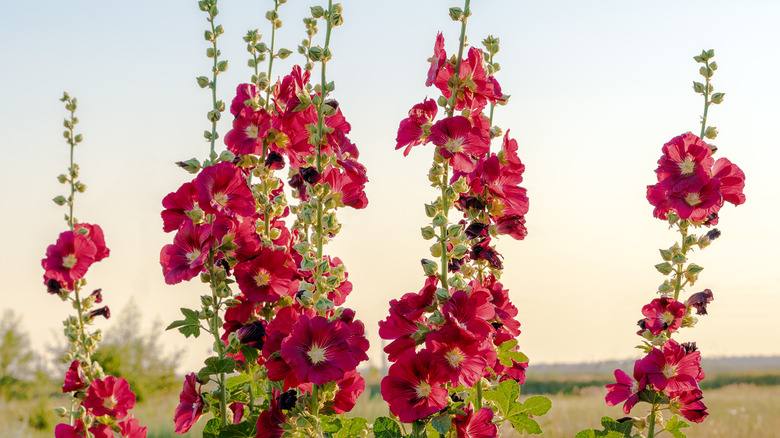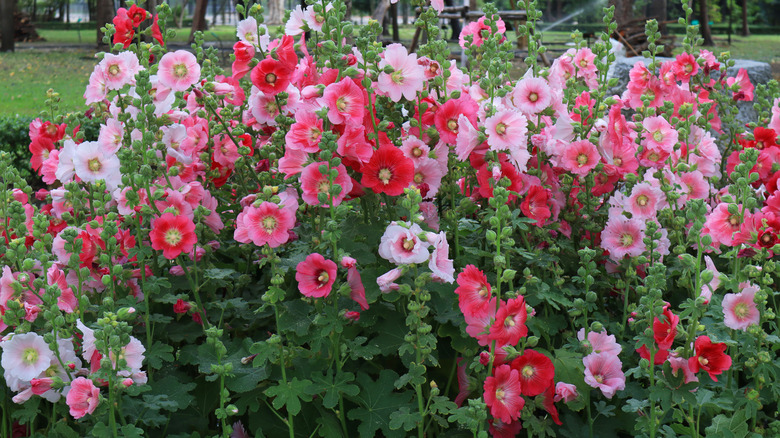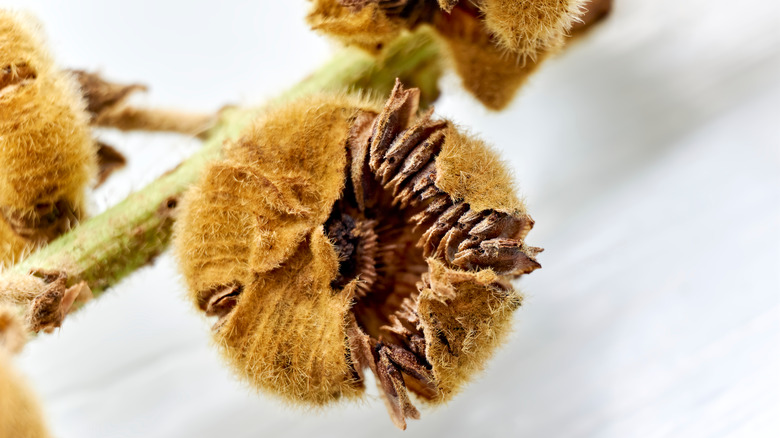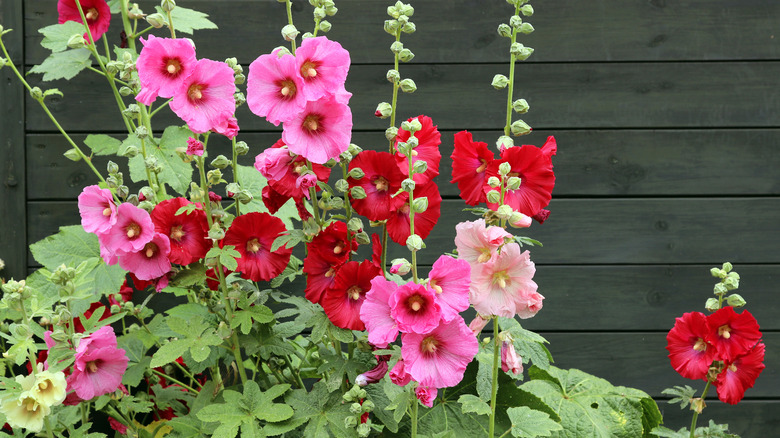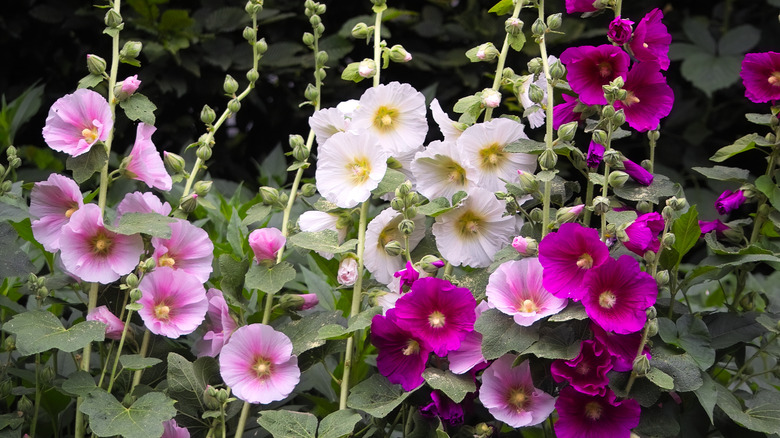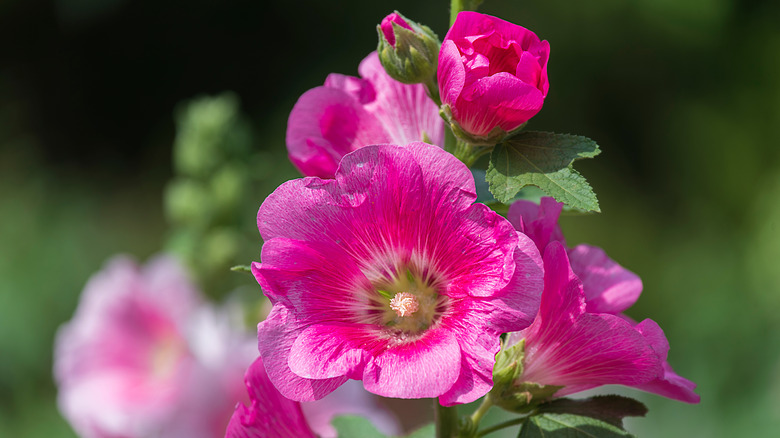Hollyhock: Everything You Should Know Before Planting
Do you want to add some height to your garden? Is nine feet tall enough? If you're seeking towering stalks with prolific blooms that will give your garden a cottage aesthetic, look no further than the hollyhock (scientific name alcea rose), per MasterClass. Its flowers are beloved by pollinators and are available in nearly every shade, so you're sure to find a variety that matches your garden's color palette.
Depending on your USDA zone, hollyhocks can be grown as perennials, biennials, or occasionally annuals. Aside from staking, they're low maintenance plants and reseed like a dream. This means that once you've got one plant established, you probably won't need to worry about any more down the road — they'll do all the work for you! Because hollyhocks can grow to such great heights and topple under their own weight, however, you may want to plant them against a wall or somewhere they'll have a little built-in support.
How to use hollyhock in the garden
Because of their potential for soaring heights up to nine feet, hollyhocks tend to command a lot of attention no matter where you plant them in your garden. Don't let this deter you, though; hollyhocks can be a beautiful accent in your cottage garden without stealing all the spotlight. Garden Design suggests using them as a backdrop flower, and placing short annuals or perennials in front. While the top half of a hollyhock stalk is filled with flowers, the lower half can look spindly and unattractive, so if this appearance bothers you, place mounding plants or those with thicker foliage in front.
If you're looking for some companion plants but are overwhelmed by all the options at your local nursery, Garden Design suggests some classic perennials like clematis, black-eyed-Susan, sweet William, and roses. Gardenista recommends phlox and coneflower as companions.
Even if you don't want to go the companion route and would like an entire section of hollyhocks on their own, just make sure to plant them in groups as we mentioned above. They'll pack the greatest visual punch this way, especially if you choose an assortment of different flower colors.
How to grow hollyhock
While it's true that hollyhocks are a good option for beginner gardeners to incorporate into their landscaping, there are some common missteps you want to avoid so that the plants will thrive. According to Gardening Know How, the main mistake that first-time hollyhock growers commit is planting the seeds or plants in soil that's too dry. Hollyhocks must have moist, well-draining soil in order to perform to their full potential.
If you choose to plant hollyhock seeds, Gardening Know How suggests sowing them about a week before the last frost. If you're using established plants, wait a few weeks after the last frost to give the ground enough time to warm up. Additionally, space the plants about two feet apart. They'll look the best if you group several together to enhance their effect. Because many varieties of hollyhock are biennials, you won't see flowers until the second year, so don't throw in the towel when the first year comes and goes with no blooms.
How to care for hollyhock
On the whole, hollyhocks do best if they're planted in full, direct sun. However, there are some varieties that can tolerate partial shade, so if this is what you're after, make sure to do your research and find a variety that won't suffer without full sun. You can plant hollyhocks in USDA zones 3 through 8.
When your hollyhocks are just starting out, you want to water them regularly and ensure the soil stays moist. Once they're established, though, they won't require routine watering. Until they reach that point, however, you need to be careful about how you water them, says Garden Design. Always water at the base of the plant and avoid splashing it all over the leaves. We'll touch on this more later, but hollyhocks are highly susceptible to leaf disease and water can exacerbate the issue.
If you're interested in fertilizing your hollyhocks, they really don't need much. Unlike other flowering plants that require lots of supplemental nutrition, hollyhocks are self-sufficient. Garden Design suggests a single, springtime application of fertilizer or rich compost and nothing else for the remainder of the growing season.
Varieties of hollyhock
Hollyhocks come in approximately 60 varieties with a rainbow of color options, single flowers or double flowers, and shorter stalks vs. taller stalks, per SF Gate. We've rounded up some of the most unique, eye-catching hollyhock varieties.
- Blacknight: The gorgeous, nearly black flowers on this hollyhock absolutely ooze drama and add an air of moodiness to your garden. It will bloom in mid-summer, reaching heights of five to six feet.
- Majorette: This hot pink hollyhock is actually a dwarf variety, which means it will only reach a height and width of about two feet. Because of this smaller size, it grows as a bushier plant and isn't as tall and spindly as its counterparts.
- Halo Series: While this variety comes in several different colors, its uniqueness comes from the dark purple center that looks like a halo against the contrasting color. It can bloom early-to-mid summer, reaching heights of five to six feet.
- Queeny Purple: Another dwarf variety, this hollyhock is perfect for containers or smaller flowerbeds thanks to its compact size. It's a lovely dark purple shade, and the flowers have more texture around the edges. It blooms mid-to-late summer.
- Indian Spring: This variety is a classic, old fashioned hollyhock. It comes in shades of pink and white, and blooms early-to-mid summer. Its height can reach up to eight feet, so give it plenty of space to stretch.
Is hollyhock toxic?
If you have pets, hollyhocks are a safe, non-toxic plant for them to be around, says the ASPCA. However, both humans and animals may experience some discomfort if their skin brushes up against the stalk or leaves. Both are covered in tiny fibers that are similar to the fine pieces of glass found in insulation and this can cause irritation, according to Garden Design.
When it comes to diseases or common problems with hollyhocks, rust is at the top of every list. Rust is a type of fungal infection that begins as spots on the leaves but then transforms into bumps and can spread throughout the whole plant. It's unsightly and travels easily from one hollyhock to another.
In order to combat a rust outbreak, Garden Design has several suggestions: You want to make sure there's good air circulation amongst the plants, always water the base of the plant and don't splash on the leaves, and remove diseased leaves as soon as they appear. Dispose of them and thoroughly clean the tool you used to remove the leaves. You can also treat hollyhocks with a fungicide, but just know that it won't do much good if you don't remedy any existing oxygen and moisture issues.
